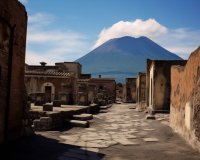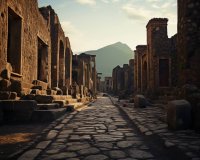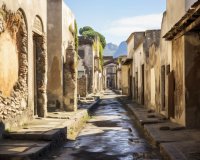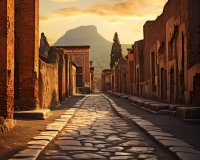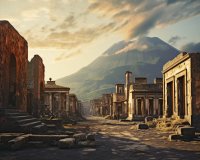From Naples to Pompeii: A Journey with a Traditional Lunch
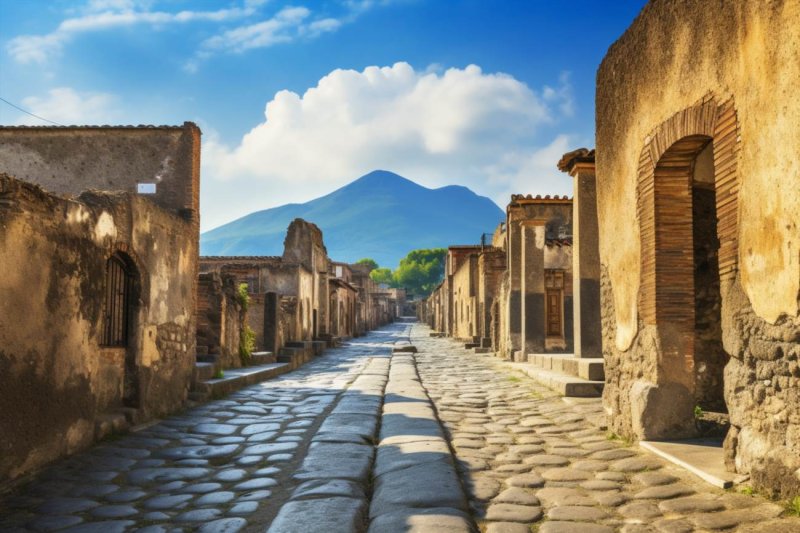
From Naples to Pompeii: A Journey with a Traditional Lunch
When it comes to exploring the rich history and culture of Italy, there are few places as captivating as Pompeii. Nestled in the shadows of Mount Vesuvius, this ancient Roman city was famously buried under volcanic ash and preserved for centuries. A journey from Naples to Pompeii promises not only a glimpse into the past but also an opportunity to savor traditional Italian cuisine.
As you embark on this unforgettable journey, you'll be treated to an immersive experience that combines history, archaeology, and gastronomy. Here's a closer look at what you can expect on your trip from Naples to Pompeii.
The Road to Pompeii
Your adventure begins in the vibrant city of Naples, where the scent of pizza wafts through the air and the lively streets are lined with colorful buildings. From here, you'll board a comfortable tour bus that will take you on a scenic ride to the archaeological wonder that is Pompeii.
During the journey, you'll be surrounded by the stunning landscapes of the Campania region, which is known for its lush vineyards, olive groves, and citrus orchards. The drive alone is a feast for the eyes and a perfect prelude to the historical wonders that await you.
Exploring the Ancient City
Upon arriving in Pompeii, you'll be guided through the well-preserved streets of this remarkable ancient city. The ruins of Pompeii offer an unparalleled opportunity to step back in time and witness the daily life of the Romans. From grand villas to humble bakeries, the city's secrets are waiting to be uncovered.
The most iconic feature of Pompeii is, of course, the Forum. This central square was the heart of the city, surrounded by temples, markets, and government buildings. As you stand in this historic space, you can almost hear the echoes of the past and feel the weight of its history.
Wandering through the narrow cobblestone streets, you'll encounter ancient frescoes, mosaics, and even the casts of Pompeii's unfortunate residents who met their end during the eruption of Vesuvius. Each corner of the city reveals a new layer of its story.
A Traditional Italian Lunch
After a morning of exploration, it's time to sate your appetite with a traditional Italian lunch. You'll be treated to a feast of local flavors, with dishes that showcase the culinary heritage of the region.
| Antipasti |
Primi |
Secondi |
Dolci |
| Bruschetta |
Pasta with fresh tomato sauce |
Grilled seafood |
Tiramisu |
| Caprese Salad |
Ravioli with ricotta and spinach |
Veal with lemon |
Cannoli |
This delectable meal includes a variety of antipasti, primi, secondi, and dolci, each prepared with fresh and locally-sourced ingredients. The flavors are a testament to the culinary prowess of Southern Italy and provide a true taste of the region.
Conclusion
A journey from Naples to Pompeii is a voyage through time and taste. You'll witness the remarkable history of Pompeii's ruins and savor the timeless flavors of Italian cuisine. It's a perfect blend of culture, heritage, and gastronomy that will leave you with lasting memories of your Italian adventure.
So, when you find yourself in Naples, don't miss the opportunity to make the short trip to Pompeii, where history and culinary delight await you at every turn.
Explore Pompeii and Vesuvius Day Tour
Discover the ancient wonders of Pompeii and Mount Vesuvius on this captivating day tour from Naples. Delve into the rich history of Pompeii, the once-great Roman city, as you roam through its incredible ruins and explore the remnants at your own pace. Witness the devastating power of Mount Vesuvius, the infamous volcano that engulfed Pompeii in 79 AD, from its majestic peak.
Tour Highlights:
- Visit the renowned archaeological site of Pompeii, offering a glimpse into ancient Roman life.
- Explore the imposing Mount Vesuvius, an active volcano with a tumultuous history.
- Gain insights into the catastrophic eruption of 79 AD that buried Pompeii and Herculaneum.
Tour Details:
This comprehensive tour, provided by Taxi Naples, ensures a seamless experience. Your package includes:
- Hotel pickup and drop-off for added convenience.
- Private transport service for a comfortable journey.
- Entrance tickets to both Pompeii and Mount Vesuvius.
- Friendly and knowledgeable drivers proficient in Italian, English, and French.
Customer Reviews:
Rated at 3.8 out of 5 based on 29 reviews, our tour has received feedback from various traveler types, including couples, solo travelers, and families. Travelers appreciate the informative guides and the opportunity to explore the sites at their own pace. Some have noted slight delays in the schedule but overall commend the experience.
Book Your Adventure:
Reserve your spot now and pay later, ensuring flexibility in your travel plans. Take advantage of this all-inclusive package to delve into the fascinating history of Pompeii and witness the awe-inspiring presence of Mount Vesuvius.
Note: Please allow 10 minutes before the activity starts for pickup.
Discovering Pompeii's Heritage
Welcome to the remarkable journey of discovering Pompeii's rich heritage, an archaeological marvel that offers a glimpse into the ancient Roman world. The city of Pompeii, located near Naples, Italy, was famously buried by the eruption of Mount Vesuvius in 79 AD. This devastating event, while catastrophic for the inhabitants, has provided us with an unparalleled time capsule of Roman life and culture.
Unearthed over centuries, Pompeii has revealed a treasure trove of insights into daily life, architecture, art, and technology from nearly 2,000 years ago. Let's embark on a virtual tour through the cobblestone streets of this ancient city.
The Tragic Tale of Pompeii
The story of Pompeii's destruction begins with the eruption of Mount Vesuvius, a stratovolcano located on the Gulf of Naples. The eruption was one of the most catastrophic in history, burying not only Pompeii but also the neighboring towns of Herculaneum and Stabiae. Thousands of lives were lost, and the cities remained lost to history for centuries.
It wasn't until the 18th century that serious excavations began, uncovering an astonishing city remarkably preserved beneath layers of ash and pumice. The painstaking work of archaeologists has brought Pompeii back to life, offering us a unique window into the past.
Everyday Life in Pompeii
Wandering through the streets of Pompeii, one can't help but marvel at the well-preserved buildings, homes, and infrastructure. The city boasts impressive architecture, including grand villas, public baths, theaters, and temples, all constructed with the advanced engineering and artistic flair of the Roman era.
One of the most striking features is the network of roads, complete with pedestrian crosswalks and stepping stones to avoid stepping into the street's filth – a testament to their urban planning and consideration for citizens. The main street, known as the Via dell'Abbondanza, was lined with shops and businesses, where residents could purchase goods and services.
Public spaces like the amphitheater and theaters were sites of entertainment and cultural gatherings. The amphitheater could accommodate up to 20,000 spectators and hosted gladiatorial contests, while the theaters showcased performances, showing the importance of leisure and culture in Pompeii.
The Homes of Pompeii
Pompeii's private residences provide a fascinating glimpse into daily life. The House of the Faun, one of the city's grandest homes, features intricate mosaics and frescoes depicting scenes from mythology and daily life. It is believed to have been the residence of a wealthy merchant.
Another notable residence, the House of the Vettii, is renowned for its opulent decorations and a garden with statuary. The preserved elements of these homes, from kitchens and dining rooms to bedrooms and courtyards, allow us to picture the daily routines and rituals of the Pompeian elite.
Pompeii's Art and Culture
Pompeii is not only a glimpse into daily life but also a treasure trove of ancient art and culture. The city's artwork, including frescoes, sculptures, and pottery, provides insight into Roman aesthetics and beliefs. Mythological scenes, landscapes, and portraits adorned the walls of homes and public buildings.
Perhaps the most famous of these is the fresco of the "Pompeian Lady," a portrait that captures the grace and beauty of a woman from antiquity. This work, along with many others, showcases the skill and artistry of the Pompeian artists.
Preserving Pompeii for the Future
Pompeii's preservation remains an ongoing challenge. The site is subject to environmental and structural threats, including erosion, vandalism, and damage from tourism. Preservation efforts are constantly underway, involving a delicate balance of maintaining the integrity of the site while allowing visitors to experience this unique historical treasure.
Exploring Pompeii's heritage is an immersive experience that connects us with the people who lived, worked, and thrived in this ancient Roman city. It is a reminder that even in the face of nature's fury, the echoes of the past can endure, and through careful excavation and preservation, we can continue to discover the wonders of Pompeii for generations to come.
In conclusion, Pompeii stands as a testament to the resilience of history and the enduring allure of the ancient world. As we walk through its cobblestone streets, we are walking through time itself, uncovering the rich tapestry of life in a Roman city frozen in a moment of tragedy and splendor.
Private Transfer from Naples to Amalfi-Ravello with Pompeii Guided Tour
Embark on a stylish journey from Naples to the enchanting Amalfi-Ravello area with our private transfer service. Your professional driver, knowledgeable and punctual, ensures a comfortable ride in a modern minivan.
Upon arrival at Naples Airport or Central Station (or your hotel), experience a seamless pick-up, with your driver holding a sign bearing your name. Relax as you traverse the scenic Sorrentine peninsula, offering breathtaking views of the bay of Naples and Capri.
As part of this exclusive package, enjoy a two-hour guided walking tour of the renowned Pompeii. Delve into the fascinating history of this ancient city with an archaeological guide. Witness key landmarks such as the Marina Gate, Basilica, Forum, Forum baths, Lupanar (brothel), and the house of the Tragic Poet, along with iconic plaster casts.
Continue your scenic journey, culminating in a drop-off at your chosen accommodation in Amalfi-Ravello. This comprehensive transfer service includes all taxes, gas, and skip-the-line admission fees, ensuring a hassle-free and informative experience.
Highlights:
- Comfortable transfer service in an air-conditioned private minivan
- Guided walking tour of Pompeii with a professional archaeologist
- Scenic drive along the Sorrentine peninsula with panoramic views
- Convenient pick-up and drop-off at Naples Airport, Central Station, or your hotel
Important Information:
- Car seats for babies available on request
Price: From €353 per person
Customer Reviews:
Rated 5/5 based on 1 review
"We booked a pick-up and tour of Pompeii on the day we landed for a long weekend. We were a family of six and as we only had a short time we wanted to see as much as we could before our return home." - September 19, 2019
Check availability and reserve your spot now. Pay later and enjoy the flexibility of your travel plans.
Savoring Italian Delicacies in Pompeii
Pompeii, the ancient Roman city that was buried under layers of volcanic ash and lava in 79 AD following the eruption of Mount Vesuvius, has captured the imaginations of history enthusiasts and archaeologists for centuries. Beyond its historical significance, Pompeii also offers a glimpse into the culinary delights of ancient Italy.
Italian cuisine is celebrated worldwide for its rich flavors, fresh ingredients, and time-honored traditions. When exploring Pompeii, one can't help but wonder what the residents of this ancient city might have enjoyed as their daily meals. The archaeological discoveries in Pompeii have shed light on the food and dining habits of the time.
Ancient Roman Dining
Ancient Romans were known for their love of food and the Pompeiians were no exception. The ruins of Pompeii have revealed various aspects of their culinary culture. They had communal bakeries, where locals would bring their dough to be baked, and numerous taverns where they could enjoy a quick meal and a cup of wine.
One of the most interesting finds in Pompeii is the thermopolium, which can be thought of as an ancient fast-food joint. These small establishments served a variety of dishes such as lentils, fish, and even spiced wine. The counters of these thermopolia are adorned with colorful frescoes that depict the food offerings, giving us a glimpse into the types of delicacies enjoyed by the Pompeiians.
The Role of Olive Oil
Olive oil was a staple of the ancient Mediterranean diet, and Pompeii was no exception. The region was well-known for its olive groves, and olive oil was used not only for cooking but also for dressing salads and preserving food. The production and trade of olive oil played a significant role in the local economy, and amphorae used for storing this precious liquid have been found in abundance.
Pompeii's Frescoes and Mosaics
The art of Pompeii also provides insight into the foods that were savored. The city's frescoes and mosaics often depicted scenes of feasting, fruits, and other culinary delights. These visual representations showcase the importance of food in the daily lives of the Pompeiians and provide a fascinating look into their gastronomic culture.
Wine and Viticulture
Wine was another integral part of the Pompeiian diet. The region's volcanic soil was excellent for grape cultivation, and Pompeii was renowned for its wines. The city had vineyards, and wine was often diluted with water and flavored with various herbs and spices, a practice known as "mulsum." The remnants of wine presses and amphorae confirm the significance of viticulture in this ancient city.
Rediscovering Pompeiian Flavors
Today, Pompeii continues to be a source of fascination for history buffs and food enthusiasts alike. Some restaurants in the modern city of Pompeii offer dishes inspired by ancient Roman recipes. Visitors can savor dishes that incorporate ingredients like olives, garum (a fermented fish sauce), honey, and spelt, which were commonly used in Pompeii's kitchens.
While the recipes may not be exact replicas of the past, they offer a taste of the flavors that once delighted the palates of Pompeiians. Dining in these establishments is a unique experience, as it allows you to connect with the culinary history of this ancient city.
In Conclusion
Pompeii's rich culinary history, as revealed through its archaeological finds and artistic representations, provides a fascinating glimpse into the dining habits of ancient Romans. The use of ingredients like olive oil, the presence of communal dining establishments, and the significance of viticulture all contribute to our understanding of Pompeii's gastronomic culture. Visiting Pompeii and savoring Italian delicacies with a historical twist is an opportunity to embark on a gastronomic journey through time.


